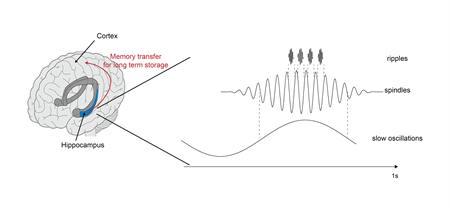Brain consolidates memory with three-step brainwave

Our long-term memory is consolidated when we sleep. Short-term memory traces in the hippocampus, an area deep in the brain, are then relocated to more outer parts of the brain. An international team of neuroscientists, among who Mathilde Bonnefond and Til Ole Bergmann from the Donders Institute at Radboud Universiy, now shows how a three-step brain oscillation plays an important part in that process. Nature Neurosciences publishes the results on September 21st.
Bonnefond and Bergmann specialize in research on oscillations: waves of brain activity. 'Non-rapid eye movement (NREM) sleep is responsible for the memory consolidation during our sleep', Bonnefond explains. 'NREM is known for its very slow oscillations (SOs). Other types of oscillations are hidden inside these SOs. We discovered that three types of oscillations are nested inside each other in the hippocampus and have a joint function.'
Slow waves, spindles and ripples
Slow oscillations only happen about once per second (~0.75 Hz). In a specific time frame within these SOs, Bergmann, Bonnefond and their colleagues found clusters of oscillations of an intermediate speed: the so called spindles which happen about 15 times per second (12 – 16 Hz). And within these spindles, they found clusters of superfast oscillations called ripples, which happen about 90 times per second (80 – 100 Hz), and which reflect the local reactivation of the memory trace to be shuttled to the cortex.
To summarize: SOs contain spindles, which in their turn contain ripples (see figure 'Bonnefond'). 'Earlier studies only coupled these oscillation types in pairs', Bonnefond explains. 'But now, we see that SOs, spindles and ripples are functionally coupled in the hippocampus. And we hypothesize that they provide fine-tuned temporal frames for the transfer of memory traces to the neocortex.'
Epilepsy
The group of researchers investigated the process in human epilepsy patients during natural sleep. Doctors were looking for the brain areas responsible for their epilepsy, and the current research was done at the same time: with special electrodes, the researchers recorded oscillations from inside the brain. Bonnefond: 'This was a great opportunity to investigate the hippocampus, since it's difficult to measure deep brain regions with classical electrophysiological techniques.'
The patients did not have to remember any specific information. 'You're consolidating memories every night, so we investigated the process in general. The next step would be to link these clustered oscillations to specific memories.'
More information: "Hierarchical nesting of slow oscillations, spindles and ripples in the human hippocampus during sleep." Nature Neuroscience DOI: 10.1038/nn.4119

















